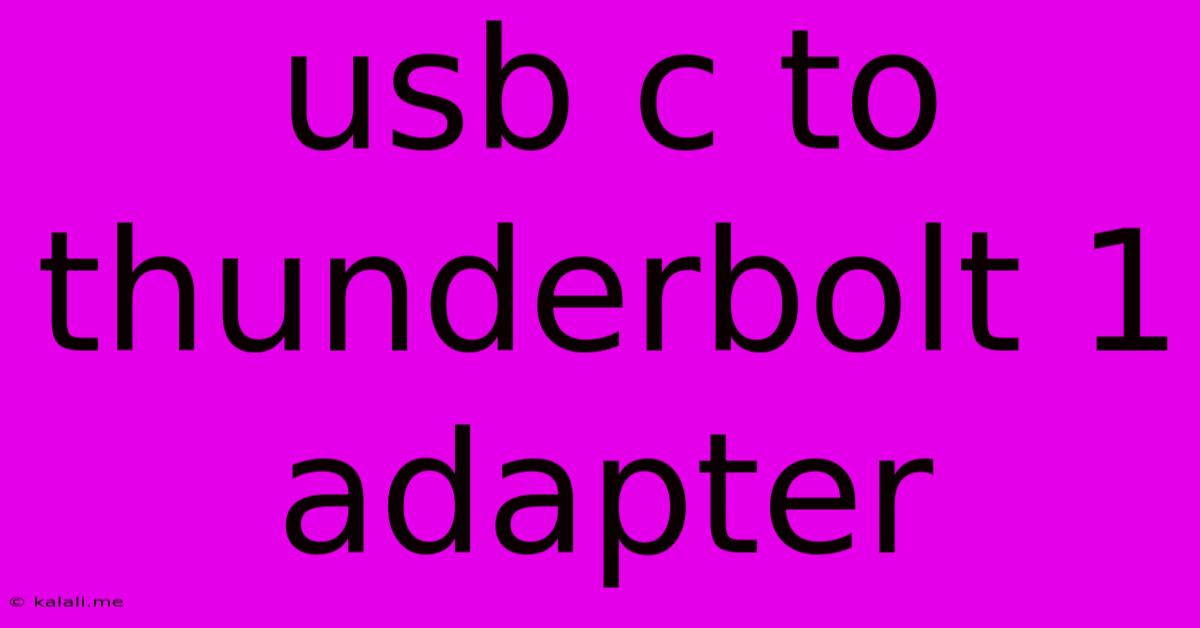Usb C To Thunderbolt 1 Adapter
Kalali
May 25, 2025 · 3 min read

Table of Contents
Decoding the USB-C to Thunderbolt 1 Adapter: A Comprehensive Guide
Meta Description: Unlock the power of Thunderbolt 1 with a USB-C adapter. This guide explains compatibility, limitations, and what to expect when connecting older Thunderbolt devices to newer USB-C ports. Learn about data transfer speeds, video output capabilities, and potential pitfalls.
Connecting older Thunderbolt 1 devices to the ubiquitous USB-C ports of modern laptops and desktops can seem tricky. This is where the USB-C to Thunderbolt 1 adapter comes in. But before you rush out to buy one, understanding its capabilities and limitations is crucial. This guide will provide a comprehensive overview, exploring compatibility, performance, and potential issues.
Understanding Thunderbolt 1 and USB-C
Before diving into adapters, let's briefly refresh our understanding of the technologies involved. Thunderbolt 1, a technology developed by Intel, offered a significant leap in data transfer speeds and video bandwidth compared to its predecessors. It leveraged the Mini DisplayPort connector. USB-C, on the other hand, is a more recent, versatile connector that supports various protocols, including USB data transfer, DisplayPort video output, and even Thunderbolt (versions 3 and 4).
The core difference is in the connector and the underlying protocols. Thunderbolt 1 uses a Mini DisplayPort connector, whereas USB-C is a more compact and universally adopted connector. This difference necessitates the use of an adapter for connectivity.
How a USB-C to Thunderbolt 1 Adapter Works
A USB-C to Thunderbolt 1 adapter acts as a translator, converting the signals from the USB-C port to the Thunderbolt 1 protocol understood by older devices. Essentially, it bridges the gap between the newer USB-C standard and the older Thunderbolt 1 standard. This allows you to connect devices like external hard drives, displays, and other peripherals that use the Thunderbolt 1 Mini DisplayPort connector to your USB-C enabled computer.
Compatibility and Limitations
While the adapter allows connectivity, it's essential to understand its limitations. The adapter does not upgrade the Thunderbolt 1 device's capabilities. You won't magically get Thunderbolt 3 or 4 speeds. Data transfer speeds will be capped at the Thunderbolt 1 specifications (10 Gbps). Similarly, video output capabilities will be limited by the Thunderbolt 1 standard's bandwidth. Attempting to use a high-resolution display with a high refresh rate might lead to performance issues or incompatibility.
Furthermore, not all USB-C ports support Thunderbolt. Some USB-C ports only provide USB data transfer capabilities. Ensure your USB-C port is Thunderbolt capable before purchasing an adapter. The port usually indicates this with a Thunderbolt icon (a lightning bolt).
Factors to Consider Before Buying
- Your Device's Compatibility: Before purchasing, meticulously check the compatibility of both your USB-C port and the Thunderbolt 1 device you intend to connect.
- Power Delivery: Some Thunderbolt devices require power. Check if the adapter supports power delivery to ensure the connected device functions correctly.
- Data Transfer Needs: Remember, the adapter limits transfer speed to Thunderbolt 1's specifications. If you need higher bandwidth, a Thunderbolt 3 or 4 adapter (if your device supports it) is necessary.
- Video Output Requirements: If using for video output, consider the resolution and refresh rate of your display.
- Adapter Quality: Choosing a reputable brand ensures better build quality and performance reliability.
Conclusion
A USB-C to Thunderbolt 1 adapter offers a solution for connecting legacy devices to modern computers. However, understanding its limitations concerning data transfer speeds and video capabilities is vital. By carefully considering the factors outlined above, you can choose the right adapter and avoid potential compatibility issues, ensuring a smooth transition between older and newer technologies. Remember always to check for Thunderbolt compatibility on your USB-C port and carefully match the adapter's specifications to your needs.
Latest Posts
Latest Posts
-
How To Get Ink Pen Out Of The Dryer
May 25, 2025
-
How To Remove A Stripped Hex Bolt
May 25, 2025
-
How To Say I Dont Speak Spanish In English
May 25, 2025
-
Mount Show Unknown Filesystem Type Lvm2 Member
May 25, 2025
-
Work Out Your Own Salvation With Fear And Trembling
May 25, 2025
Related Post
Thank you for visiting our website which covers about Usb C To Thunderbolt 1 Adapter . We hope the information provided has been useful to you. Feel free to contact us if you have any questions or need further assistance. See you next time and don't miss to bookmark.